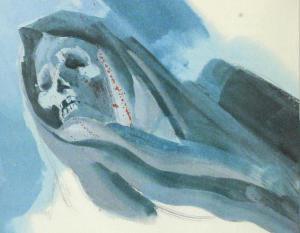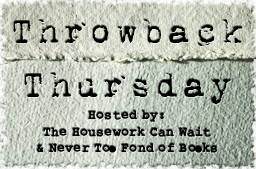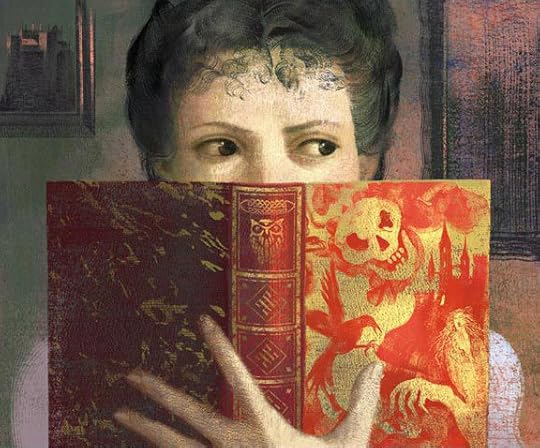Katherine Nabity's Blog, page 244
August 10, 2012
Friday Free-for-All (08/10/12)
 A couple of weeks ago, I came across Steampunk: Poe at the digital library and put a hold on it. I didn’t pay too much attention to the book’s description and figured that it was an anthology of writers steampunking-up Poe tales. Which I thought had the potential of being good, or at least interesting. Instead, Steampunk: Poe is Poe’s original tales illustrated in steampunk style by Zdenko Basic and Manuel Sumberac. This didn’t work for me. The art is beautiful (though Kindle Cloud Reader doesn’t do it justice), but it just doesn’t go with the stories. That’s probably because Poe has a very visual style and I have very specific images in my head when I read. I don’t have room for other people’s new re-imaginings. (But, I’m interested in the duo’s illustration of steampunk Frankenstein. I don’t recall Shelley quite as vividly.)
A couple of weeks ago, I came across Steampunk: Poe at the digital library and put a hold on it. I didn’t pay too much attention to the book’s description and figured that it was an anthology of writers steampunking-up Poe tales. Which I thought had the potential of being good, or at least interesting. Instead, Steampunk: Poe is Poe’s original tales illustrated in steampunk style by Zdenko Basic and Manuel Sumberac. This didn’t work for me. The art is beautiful (though Kindle Cloud Reader doesn’t do it justice), but it just doesn’t go with the stories. That’s probably because Poe has a very visual style and I have very specific images in my head when I read. I don’t have room for other people’s new re-imaginings. (But, I’m interested in the duo’s illustration of steampunk Frankenstein. I don’t recall Shelley quite as vividly.)
I’ve been a Poe fan since I could read, more or less. I distinctly remember in 3rd-grade, or thereabouts, repeatedly checking out illustrated children’s versions of The Masque of the Red Death and The Pit and the Pendulum (as well as The Monkey’s Paw and a particularly creepy haunted boat cabin story that I don’t remember the name of). While it seemed pretty reasonable as a kid to have these in our teeny-tiny Lutheran school library, as an adult I started to doubt their existence. But I’d search the internet every-so-often looking for the illustrated Poe I know. On Wednesday, I found Red Death, complete with the startling cover I remember:
“Edgar Allan Poe’s The masque of the red death.” adapted by David E. Cutts & illustrated by John Lawn. Published 1982 by Troll Associates. Mahwah, N.J .
The best illustration in the book is page 24: The blood splatters that don’t quite go with the picture creeped-out 8-year-old me. These books, though abridgements, were my first taste of Poe and other creepy tales and have definitely influenced how I “see” those stories.
The blood splatters that don’t quite go with the picture creeped-out 8-year-old me. These books, though abridgements, were my first taste of Poe and other creepy tales and have definitely influenced how I “see” those stories.
Lastly, The Guardian brings us the Edgar Allan Poe Death Scene Infographic.

by Adam Frost, Jim Kynvin and Jamie Lenman
Click through for a better look. I’m particularly amused by the “Simian Involvement” category.

August 9, 2012
Throwback Thursday (08/09/12)
Throwback Thursday is a weekly meme hosted by The Housework Can Wait and Never Too Fond of Books!
Noting that book blogging onften focuses on new releases, here’s how Throwback Thursday works:
Pick a book released more than 5 years ago.
Write up a short summary of the book (include the title, author, and cover art) and an explanation of why you love it.
Link up your post at The Housework Can Wait or Never Too Fond of Books.
Visit as many blogs as you can, reminisce about books you loved, and discover some “new” books for your TBR list!
To Kill a Mockingbird by Harper Lee
 From my original post, 10/27/08:
From my original post, 10/27/08:
This is one of the many Great American Classics that I managed never to read despite honors English classes in high school and a BA in English in college. I know it might seem strange to compare this book to two lesser books in the great classics scheme, but I will do so. I’ve never held with the notion of literature existing in a vacuum or only in the context of the time it was written. While reading, I couldn’t help but make comparisons to Berent’s Midnight in the Garden of Good and Evil. Both are Southern novels (though Midnight is actually nonfiction) and both deal with crime and the court system. Both are filled with Southern peculiarities, though the primary difference is that Berent’s is from the perspective of an outsider and is an order of magnitude more tabloid in its treatment. (Not saying that Midnight is strongly tabloid at all.) Both are exquisitely written. The other novel that kept coming to mind is Alice Sebold’s Almost Moon. Yeah, I know, I’m comparing a Classic with a book that no one likes. One of the things that Sebold does well with Moon is that she doesn’t look away from the nastiness that being human can be. Lee doesn’t either. Ex., Mrs. Dubose is not pleasant and Scout’s attitudes toward her are rather cruel. And that’s a good thing. No character should ever be entirely sweetness and light (or pure evil for that matter).
As for the Issues of the book, much can and has been said. Honestly, I thought it got a little too didactic at the end instead of continuing to show attitudes through the behavior of the characters. As with many books, I wish I had read it earlier in life. Scout’s a great tom-boy character and I would have appreciated her more at a time in my life when I needed her. Great book though.
Not much else to add. This book is a classic for a reason.

August 8, 2012
Book #22
 As I said on Monday, in the past when I considered reading this book, I was dubious. Vampires and werewolves in steampunk London with a parasol wielding heroine? There are so many ways this can go horribly wrong. But for the most part, it doesn’t.
As I said on Monday, in the past when I considered reading this book, I was dubious. Vampires and werewolves in steampunk London with a parasol wielding heroine? There are so many ways this can go horribly wrong. But for the most part, it doesn’t.
I”m going to compare this book to most Joss Whedon projects. There is a gap between how plausibly good the average Joss Whedon project should be and how much fun it really is. (This analogy does rely on one believing that Joss Whedon has a few good project to his name. If you don’t care for Buffy the Vampire Slayer, Angel, or even Firefly, you’re probably not going to be inclined to read this book anyway.) Even The Avengers shouldn’t be as much fun as it is, but it comes down to characters. Give me characters I like and I’ll forgive quite a few sins.
I also might be a little softer on this book because I’m (relatively) new to steampunk and not overly jaded when it comes to bodice-ripping romance novels. I’ve somewhat accepted the fact that no writer is going to handle steampunk world building as well as I’d like. It is, basically, science fiction set in the 19th century. Going back and rebuilding the world with new technologies (and supernatural aspects) and the ramifications of those things is a task. I’m certainly not saying that I could do it well. I maintain that the best policy as an author in regards world building is to either be exhaustive* or shut up. Gail Carriger present her world, but doesn’t over-explain. I’m okay with that…
…because I’m too busy enjoying myself. The situations have a level of absurd comedy that I enjoyed. The characters were maybe a little too stereotyped, but there is a lot going on in the book. If your world is already quirky, it might be okay to lighten up on the character eccentricities. The plot did a decent job of presenting one story as well as setting up the series. The language sparkled. Occasionally, there was too much attention paid to clothing, but that fits more with (my preconceptions about) the Victorian setting. I didn’t feel the epilogue was particularly needed, but I can see where the romance novel fans might want that sort of thing.
I suppose the true test might be, am I going to read the other books in this series? There are four more. I’m not sure. I’m certainly not going to do it now. While a few hours of fun and a nice break, I’m not up for more fluff just yet.
*If you go the exhaustive route, you don’t need to share every last detail with your reader, but you do need to know all the details.
Format: Kindle Cloud Reader
Procurement: Greater Phoenix Digital Library

August 6, 2012
It’s Monday, What Are You Reading? (08/06/12)
This Week I’m Reading:
 Soulless by Gail Carriger
Soulless by Gail CarrigerAlexia Tarabotti is laboring under a great many social tribulations. First, she has no soul. Second, she’s a spinster whose father is both Italian and dead. Third, she was rudely attacked by a vampire, breaking all standards of social etiquette.
Where to go from there? From bad to worse apparently, for Alexia accidentally kills the vampire—and then the appalling Lord Maccon (loud, messy, gorgeous, and werewolf) is sent by Queen Victoria to investigate.
With unexpected vampires appearing and expected vampires disappearing, everyone seems to believe Alexia responsible. Can she figure out what is actually happening to London’s high society? Will her soulless ability to negate supernatural powers prove useful or just plain embarrassing? Finally, who is the real enemy, and do they have treacle tart?
SOULLESS is a comedy of manners set in Victorian London: full of werewolves, vampires, dirigibles, and tea-drinking. (Goodreads)
My library loan on this one is running out! Eeep!
I believe it earned a hard eye roll from me the first time I read the jacket summary, but so far it’s been really fun.
Short Story of the Week:
Clarksworld #71 has stories from Kij Johnson and Catherynne M. Valente. I believe I’ll be dipping into that this week.
The Usual:
A poem, a chapter of A Storm of Swords, and the next section of Edda. (I forgot of Friday that I had something vaguely literary to say about the last section of Poetic Edda I read. Maybe I’ll get around to writing it up this week.

August 3, 2012
Friday Free-for-All (08/03/12)
Tor’s Picturing Books is a feast for a book lover’s eyes. Books due seem to have a quality of movement and character (without being anthropomorphized) that may be lacking in art featuring electronic reading devices.
—###—
Press Play features a video essay about TMNT, Ninja Turtles: Generation Y in a Half Shell. I would contend though that they’re not really talking about generation Y as a whole but the years that straddle Gen X and Gen Y. Gen X is the latchkey generation while Gen Y has been more doted on as children. True, TMNT lacks the gung-ho optimism of GI Joe, but to some degree one is an answer to the other.
—###—
On the heels of an article about another former Twilight fanfic being purchased (for seven figures!), I briefly got sucked into discussion of why Twific is different than other fanfic. From Anne Jamison’s blog about her 2010 course on Pop Culture Theory:
How many different Edwards and Bellas could you read or write about? Why are you using a story about annoyingly chaste teenagers to write erotica about damaged adults? Why are your characters still Edward and Bella if Edward is a tattoo artist or a high school principal or just high? If you’re publishing online for free, why are you erecting the same hierarchical structures I see in the publishing world? In a non-profit world, why are you advertising all these products in your fics? Why are MFAs writing Edwards and Bellas alongside tweens who don’t know sentences need verbs?
While I’ve read a share of fic from different fandoms, it does seem rather puzzling. What’s the point of having characters be certain characters if they’re not those characters? Is it shorthand for characteristics? Color me fifty shades of befuddled.
Read this Week:
Lovely, evocative story by Ken Lui at Electric Velocipede, “Cutting”.

August 2, 2012
Throwback Thursday (08/02/12)
Throwback Thursday is a weekly meme hosted by The Housework Can Wait and Never Too Fond of Books!
Noting that book blogging onften focuses on new releases, here’s how Throwback Thursday works:
Pick a book released more than 5 years ago.
Write up a short summary of the book (include the title, author, and cover art) and an explanation of why you love it.
Link up your post at The Housework Can Wait or Never Too Fond of Books.
Visit as many blogs as you can, reminisce about books you loved, and discover some “new” books for your TBR list!
Lunar Park by Bret Easton Ellis
 I have a love/hate relationship Bret Easton Ellis. It took me a long time to get through American Psycho. Probably over a year. Not due to the violence of it, but the sheer alien quality of the the 80s GQ world that Ellis presents in hyper-real detail. This wash of details is boring and compelling at the same time. I don’t know how he does it.
I have a love/hate relationship Bret Easton Ellis. It took me a long time to get through American Psycho. Probably over a year. Not due to the violence of it, but the sheer alien quality of the the 80s GQ world that Ellis presents in hyper-real detail. This wash of details is boring and compelling at the same time. I don’t know how he does it.
I read Lunar Park because it was nominated for the World Fantasy Award. Why it wasn’t nominated for a the Stoker? I don’t know that either. It’s one of the more uneasy horror novels I’ve read.
Lunar Park starts slow. Ellis sets up a fictional reality and then writes a memoir ghost story. The set up is everything I disliked about American Psycho. There is a steady stream of details that gets tiring, boring. Honestly, I’m not sure why I kept reading aside from a certain momentum that pulls a reader through. Thankfully, this doesn’t last as long as it does in American Psycho. Once the fictional Bret Easton Ellis is established, the story moves, meticulously setting up an atmosphere of dread. I wasn’t expecting a ghost story or the mild return of Patrick Bateman or a meditation on being a writer and the lives of a writer’s creations. Getting all three was something of a treat. And I wonder what epic fantasy readers think of Lunar Park being included as one of the best fantasies of the year. Or what the ‘literary’ reader would think of it being shelved in the non-genre section. Sadly, without the former I would have missed out on one of the best horror novels I’ve read in a long while.
Why read it today? It’s another great horror example of “home” become something uncanny and disturbing. This book is work, but it’s worth it. For the last month or so, I’ve been wanting to reread Lunar Park. I checked it out from the library in 2006 and have considered buying it in the past on at least one occasion. I finally bit the bullet and ordered it from Amazon earlier this week. I plan on reading it during Bout of Books.

August 1, 2012
Thrown Against the Wall: A Grumpy Review of Beautiful Disaster
The new Abby Abernathy is a good girl. She doesn’t drink or swear, and she has the appropriate percentage of cardigans in her wardrobe. Abby believes she has enough distance between her and the darkness of her past, but when she arrives at college with her best friend, her path to a new beginning is quickly challenged by Eastern University’s Walking One-Night Stand.
Travis Maddox, lean, cut, and covered in tattoos, is exactly what Abby needs—and wants—to avoid. He spends his nights winning money in a floating fight ring, and his days as the ultimate college campus charmer. Intrigued by Abby’s resistance to his appeal, Travis tricks her into his daily life with a simple bet. If he loses, he must remain abstinent for a month. If Abby loses, she must live in Travis’s apartment for the same amount of time. Either way, Travis has no idea that he has met his match. (via Goodreads)
This isn’t normally the type of book I might read, but I’m not afraid to cross genre lines. I’d seen this book around and read its positive blurbs. Since NetGalley was offering it as a “Read Now” in advance of its August 14th Simon & Schuster release, I figured I’d give it a look.
 I read the first two chapters, not quite 50 pages, before I threw in the towel. It felt like so much more than 50 pages without covering any story at all. According to the chapter headings, the bet mentioned in the summary, which would seem to be the crux of the story, isn’t for another 20 pages. While I realize that the summary of a book should be an enticing distillation of the story, this book’s plot and characterization seem very watered down. I get no sense in these first couple chapters that Abby is a particularly “good girl” or that she’s trying very hard to avoid being “bad.” Instead, she seems pretty ordinary with an unhappy family situation.
I read the first two chapters, not quite 50 pages, before I threw in the towel. It felt like so much more than 50 pages without covering any story at all. According to the chapter headings, the bet mentioned in the summary, which would seem to be the crux of the story, isn’t for another 20 pages. While I realize that the summary of a book should be an enticing distillation of the story, this book’s plot and characterization seem very watered down. I get no sense in these first couple chapters that Abby is a particularly “good girl” or that she’s trying very hard to avoid being “bad.” Instead, she seems pretty ordinary with an unhappy family situation.
Our bad boy, Travis, is in awesome shape without working out, very smart but engages in bare knuckle boxing because of his abusive past, and is so good looking that girls will sleep with him because he exists. And apparently because no women can resist the opportunity to try and change a bad boy. Except Abby and her best friend who is dating Travis’ best friend. When Abby sees Travis for the first time at one of his fights, she is attracted and repulsed. Since she’s the impenetrable good girl, he wants her. Thus begins a tiresome, to me, cycle of “I want him, but he’s still a womanizing putz” and “she doesn’t want me, so I’ll just continue to be a womanizing putz.” A story like this relies on Travis being, on some level, appealing even at the beginning of the book before any bad-boy redemption occurs. I don’t find him so and an given no reason to stick with this story.
Maybe I’m just too old, too removed from my college days. Or maybe my college days were thankfully free of bad-decision-men and dormitories with broken boilers.
On a personal experience level, the setting weirdly seems more like high school than college. Everyone meets for lunch, despite dinner being more likely due to variable class schedules. Travis and America’s boyfriend live off-campus, but eat at the cafeteria. Everyone seems to be taking the same low-level courses. Why aren’t Abby and America roommates? Most universities are pretty good about letting friends room together. Unless its winter, a cold shower isn’t the end of the world and any university with a budget would have the boiler fixed quickly. The girls would probably spend 1-2 nights off campus at most, if they couldn’t stand a cold shower. I realize that my experience at a large state university might be different from that of a student at a small college, but I found these things distracting.
Also, I’m really tired of male characters giving female characters diminutive nicknames within the first five minutes of meeting them. The nickname Pidge, short for the nickname Pigeon, isn’t cute (or even neutral) enough to be amusing and doesn’t have the intimacy behind it to be endearing. It just…grates.
Format: Adobe Digital Edition of the Simon & Schuster edition.
Procurement: NetGalley

July 30, 2012
It’s Monday, What Are You Reading? (07/30/12)
This Week I’m Reading:
Didn’t get much reading done last week. I can link to last week’s post and be pretty accurate about what I’m reading this week. What’s up with that? Been a little blah, been playing too much EverQuest 2. There’s the Olympics and set up for our fall ultimate frisbee league. And maybe I’m just a tad burnt out on reading. I’m going to take it easy for a couple of weeks and then come down with another Bout of Books. ;)
The Usual:
Time to call a moratorium on things I’m “behind” on. My general goals this year were to read 30 books (I’m 4 books ahead of schedule according to Goodreads), keep up with the A Clash of Kings read-through (I’m finished), and read a short story and poem per week (I’ve read 58 and 82 respectively). I’m hitting the reset button and moving on.
Happy Reading!


July 27, 2012
Friday Free-For-All (07/27/12)

Count Dracula
Brian Joseph Davis creates and curates The Composites: Images created using a commercially available law enforcement composite sketch software and descriptions of literary characters. Above is Count Dracula based on Stoker’s original text:
A tall old man, clean shaven save for a long white moustache…His face was a strong, a very strong, aquiline, with high bridge of the thin nose and peculiarly arched nostrils, with lofty domed forehead…His eyebrows were very massive, almost meeting over the nose, and with bushy hair that seemed to curl in its own profusion. The mouth, so far as I could see it under the heavy moustache, was fixed and rather cruel-looking…For the rest, his ears were pale, and at the tops extremely pointed. The chin was broad and strong, and the cheeks firm though thin…The blue eyes transformed with fury.
***
Lev Grossman talks about when you hate the book you’re reading. I can relate. I’ve been a pretty grumpy reviewer lately. This especially rings true, and for agents reading submissions as well as readers:
As far as I can tell what happens when a reader loves a book isn’t actually a wondrous explosion of literary greatness, an inevitable consequence of that book’s inherent value, it’s a complicated combination of all sorts of circumstances: like who the reader is, where they are in their lives, what else they’ve read, what mood they’re in at the exact moment when they pick up the book, whether they’re drunk or sober, what sorts of bullshit they will or won’t put up with (and all novels contain a certain amount of bullshit), whether the author photo looks like their ex-girl/boyfriend, etc. etc.
***
Related to recent blog entries:
On Comic and Continuity
Horror’s Hearth and Home: The Use of Setting in American Gothic Fiction by Steven Wedel

July 26, 2012
Throwback Thursday (07/26/12)
Throwback Thursday is a weekly meme hosted by The Housework Can Wait and Never Too Fond of Books!
Noting that book blogging onften focuses on new releases, here’s how Throwback Thursday works:
Pick a book released more than 5 years ago.
Write up a short summary of the book (include the title, author, and cover art) and an explanation of why you love it.
Link up your post at The Housework Can Wait or Never Too Fond of Books.
Visit as many blogs as you can, reminisce about books you loved, and discover some “new” books for your TBR list!
No Life for a Lady by Agnes Morley Cleaveland
 From the original post (12/28/05):
From the original post (12/28/05):
Loved No Life for a Lady. Agnes Morley Cleaveland had a great voice and imparts history in the form of “I was there.” The books covers the rise and fall of New Mexico cattle baronies. It’s a book I’m glad I stumbled across.
In my yearly wrap-up post:
After I moved to AZ, I began to take an interest in the history of here and Nebraska. Pioneer history. I picked this book, and another of similar subject, at the Tempe Library sale. Ironically, they were published by the University of Nebraska-Lincoln (my alma mater).
Why should you read it today? It’s history, entertaining history. Cleaveland’s anecdotes are filled with humor without sugar-coating hardships. It’s sometimes easy to forget that during same era as corsets, bustles, and parasols, there were women taking care of their homestead’s business matters, fending off bandits and bears, rounding up lost horses, and becoming educated while their men-folk were off driving cattle and taking care of other matters.








